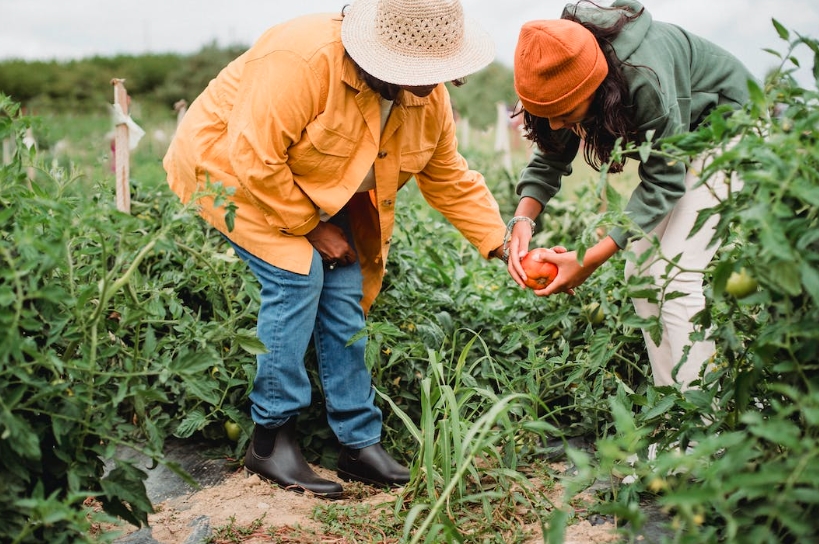Harvest Time: The Art of Vegetable Gardening is a timely topic to explore as we enter the season of gathering our crops. Nothing beats the feeling of harvesting the fruits of your labor in the garden, and the added benefit is that you get to enjoy the nutritional, delicious, and freshness of homegrown vegetables. Vegetable gardening is a great way to add variety to your meals, provide nutrition and exercise, and, most importantly, connect with nature. This article will explore the basics of vegetable gardening, from planning and growing, to harvesting and storage, and will provide helpful tips and resources to ensure successful vegetable harvests.
For those looking to get a jump start on their vegetable garden, some of the most important considerations are the type of vegetables to grow, the location of the garden, and the timing of the planting and harvesting. With the right combination of these elements, it is possible to enjoy a bountiful harvest of vegetables that are both delicious and nutritious. Additionally, understanding the necessary soil and water requirements, as well as pest and disease control, are key factors in successfully growing vegetables. Finally, proper harvesting and storage techniques can help maximize the longevity of the vegetables and ensure that they are enjoyed for the longest time possible.
Preparing for Harvest Time
Discuss the importance of planning and preparing for harvest time
A. Planning ahead for harvest time is essential for a successful and bountiful harvest. Planning helps to ensure that the garden is well-maintained and that the vegetables are harvested at the ideal time for maximum flavor and nutrition. It also prevents over-harvesting, which can deplete the soil of essential nutrients and lead to decreased yields in future harvests.

B. Planning should include preparing the soil for planting, choosing the right varieties of vegetables for the climate, and deciding when to plant and harvest. It is important to plan ahead in order to ensure that the vegetables have enough time to ripen before the growing season ends and to prevent any problems with pests or diseases.
Provide tips for maintaining a healthy garden during the growing season
A. Regular watering and fertilizing are essential for a healthy garden during the growing season. Watering should be done deeply and consistently throughout the season to ensure that the vegetables get enough water for optimal growth and development. Fertilizing should be done according to the specific needs of the vegetables and should be done at least once a month.
B. It is also important to keep the weeds at bay by regularly weeding the garden. Weeds can compete with the vegetables for water and nutrients and can also harbor pests and diseases that can harm the vegetables. Regular weeding can help to prevent these issues and ensure a healthy garden.
Explain how to determine when vegetables are ready for harvest
A. Knowing when vegetables are ready for harvest can be tricky and requires some knowledge of the individual vegetables. Different vegetables have different signs of readiness, such as color, size, texture, and flavor. It is important to know these signs so that the vegetables can be harvested at the optimal time for maximum flavor and nutrition.
B. Additionally, it is important to harvest the vegetables at the right time in order to prevent over-ripening, which can diminish the flavor and nutrition of the vegetables. Additionally, over-ripening can result in the vegetables becoming too soft and mushy, rendering them inedible.
Harvesting Techniques
Harvesting vegetables is a critical part of gardening, as it allows you to reap the rewards of your hard work. However, it is important to know the proper techniques for harvesting different types of vegetables, as well as how to handle and store them safely.
Harvesting Different Vegetables:
• Root vegetables, such as potatoes, carrots, and turnips, should be harvested as soon as they are mature. Carefully loosen the soil around the plant, then lift the vegetable out of the ground.
• Leafy vegetables, such as lettuce and spinach, should be harvested by cutting the entire plant at the base of the stem.
• Vine vegetables, such as tomatoes and cucumbers, should be harvested when they are fully ripe. Gently twist the fruit off the vine.
• Fruit trees, such as apples, pears and cherries, should be harvested when the fruit is ripe. Gently pull the fruit off the tree, being careful not to damage the branches.
Safely Handling and Storing Harvested Vegetables:
• Harvested vegetables should be handled gently to avoid bruising them.
• Place harvested vegetables in a container that is lined with a damp cloth or paper towel to help keep them cool and moist.
• Store harvested vegetables in the refrigerator as soon as possible.
Harvesting Without Damaging the Plant or Soil:
• Use sharp tools, such as pruning shears, when harvesting to ensure a clean cut.
• Be careful not to pull or tug on the plant as this can damage the roots.
• When harvesting root vegetables, be careful to not damage the surrounding soil. Use a garden fork to loosen the soil around the plant before harvesting.
• When harvesting leafy vegetables, leave some of the leaves on the plant so that it can continue to produce.
• After harvesting, replace the soil around the plant and water it to help the plant recover.
Maximizing Your Harvest
Strategies for Maximizing Your Harvest
1. Succession Planting: Succession planting is a method of planting crops in succession to get multiple harvests over an extended period of time. This involves planting a second crop, or a succession of crops, right after the first one has been harvested. It allows you to take advantage of the same soil, tools, and labor while producing a larger yield.
2. Crop Rotation: Crop rotation is a technique employed by farmers to ensure that their soil remains fertile and the crops remain productive. By rotating the crops planted in a particular area from year to year, the soil is replenished with nutrients, and the threat of disease is minimized.
Extending the Harvest Season
1. Row Covers: Row covers are lightweight fabric covers that can be used to protect plants from frost, strong winds, and pests. They can also be used to create a microclimate around the plants, allowing them to be harvested earlier in the season.
2. Cold Frames: Cold frames are small enclosures that are placed over a bed of soil and can be used to extend the growing season. They are typically built with a transparent cover, such as glass or plastic, which traps heat and allows the plants to be grown in cooler temperatures.
Preserving Excess Harvest
1. Canning: Canning is a method of preserving food by sealing it in airtight containers. This prevents bacteria from growing and spoiling the food, and allows it to be stored for long periods of time.
2. Freezing: Freezing is a method of preserving food by rapidly cooling it to below freezing temperatures. This prevents bacteria from growing and spoiling the food, and allows it to be stored for long periods of time.
3. Drying: Drying is a method of preserving food by removing the moisture content. This prevents bacteria from growing and spoiling the food, and allows it to be stored for long periods of time.
Common Harvest Time Challenges
Identify Common Challenges that Gardeners Face During Harvest Time
Pests: One of the most common challenges that gardeners face during harvest time is pests. Insects such as aphids, mites, beetles, and caterpillars can cause significant damage to crops. In addition, larger pests such as deer, squirrels, and birds can also wreak havoc on gardens.
Diseases: Gardeners also need to be vigilant about diseases that can infect their crops. Fungal diseases, such as powdery mildew, can quickly spread and cause extensive damage to sensitive plants. Additionally, bacterial diseases, such as bacterial leaf spot, can also cause major problems for gardeners.
Weather Conditions: Weather conditions can have a significant impact on gardens. Droughts, excessive rainfall, and extreme temperatures can all cause stress to plants, leading to wilting, nutrient deficiencies, and other problems. Additionally, strong winds can cause damage to crops and even uproot entire plants.
Provide Solutions for Mitigating or Overcoming These Challenges
Pests: To mitigate pest damage, gardeners should practice good garden hygiene and use physical barriers, such as fences and netting, to keep pests away from their crops. In addition, gardeners can also use natural pest control methods, such as planting companion plants and introducing beneficial insects, to discourage pests from attacking their crops.
Diseases: To prevent the spread of diseases, gardeners should practice crop rotation to reduce soil-borne diseases. Additionally, gardeners should avoid overhead watering and use disease-resistant varieties whenever possible.
Weather Conditions: Gardeners can use mulch to help retain moisture in the soil and protect plants from extreme temperatures. Additionally, gardeners can use shade cloths to protect tender plants from intense sunlight.

Discuss the Importance of Maintaining a Healthy Garden Ecosystem to Prevent Future Challenges
A healthy garden ecosystem is essential for preventing future challenges. A well-balanced ecosystem is one that has a variety of plant species, beneficial insects, and other organisms that can help keep pests and diseases in check. Additionally, a healthy garden ecosystem can help protect plants from extreme weather conditions by providing shelter and shade from the elements.
To maintain a healthy garden ecosystem, gardeners should practice natural pest control methods, use companion planting, and avoid the use of chemical pesticides and fertilizers. Additionally, gardeners should strive to create a diverse landscape that includes native plants and beneficial insects. By doing this, gardeners can create a garden that is better equipped to handle the challenges of harvest time.
Conclusion
Harvest time is a time of celebration and joy for vegetable gardeners. It is a time to enjoy the fruits of one’s labor, to marvel at the beauty of the vegetables, and to savor the flavor of the freshly picked produce. While the process of vegetable gardening can be time consuming and labor intensive, the rewards of a successful harvest make it all worth it. Through careful planning, proper soil preparation, and careful maintenance, vegetable gardeners can enjoy a bountiful harvest full of fresh, nutrient-rich vegetables that are sure to please the palate. Harvest time is a reminder of the hard work and dedication put forth by vegetable gardeners, and the joy that comes with the rewards of a successful harvest.
FAQs
1. What is the best time to harvest vegetables?
The best time to harvest vegetables is when they are at their peak of maturity. This varies depending on the type of vegetable and the variety you are growing. Generally, vegetables should be harvested when they are firm and brightly colored.
2. How do I know when vegetables are ready to be harvested?
The best way to tell when vegetables are ready to harvest is to check the seed package or planting instructions for the variety of vegetable you are growing. The instructions should provide information on the optimal maturity stage for harvesting. In addition, you can look for signs of maturity, such as the color of the vegetable and its size.
3. How do I harvest vegetables properly?
Depending on the vegetable you are harvesting, you may want to use a knife or your hands. When using a knife, it is important to make sure it is clean and sharp. When using your hands, make sure to be gentle and avoid pulling or tugging on the vegetable.
4. How long can I store harvested vegetables?
The storage life of vegetables depends on the type of vegetable and the storage conditions. Generally, vegetables should be stored in a cool, dark, and dry place. Most vegetables can last for a few days to a few weeks when stored properly.
5. What are some tips for harvesting vegetables?
When harvesting vegetables, make sure to wear gloves to protect your hands, and use a clean, sharp knife or your hands. Avoid bruising or tearing the vegetables, as this can reduce their shelf life. Additionally, make sure to harvest vegetables at their peak of maturity for the best flavor and quality.
6. What is the best way to store harvested vegetables?
The best way to store harvested vegetables is in a cool, dark, and dry place. Make sure to check the vegetables regularly for signs of spoilage. Additionally, avoid washing vegetables until you are ready to use them, as this can reduce their shelf life.
7. Is it better to harvest vegetables early or late?
It is best to harvest vegetables at their peak of maturity, as this is when they will have the best flavor and quality. If you harvest too early, the vegetable may not have fully developed, and if you harvest too late, the vegetable may have become overripe.
8. What are the benefits of harvesting vegetables?
Harvesting vegetables provides a number of benefits, including freshness, flavor, and nutrition. Additionally, harvesting your own vegetables gives you control over the quality of the produce, and can help you save money.
9. How often should I harvest vegetables?
The frequency of harvesting depends on the type of vegetable and the variety you are growing. Generally, you should harvest vegetables when they are at their peak of maturity, and this will vary based on the type and variety of vegetable.
10. What tools do I need to harvest vegetables?
Generally, you will need a sharp knife or pruning shears to harvest vegetables. Additionally, you may want to wear gloves to protect your hands from the sharp edges of the knife or shears.


















